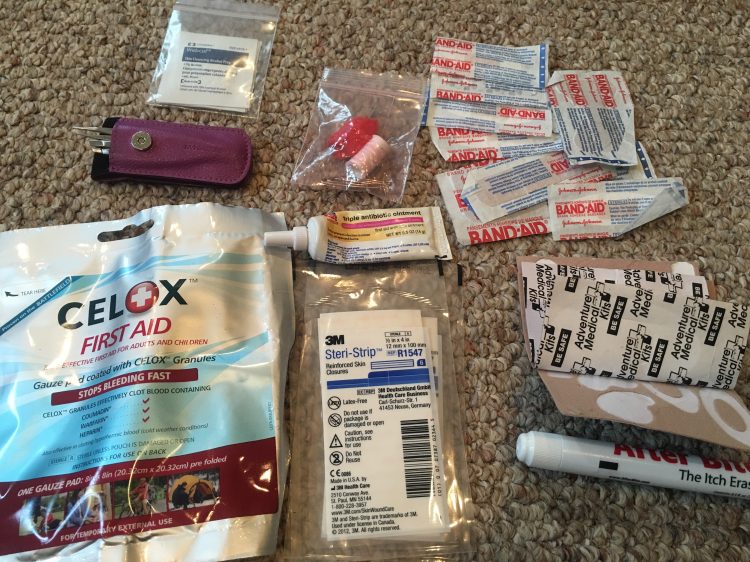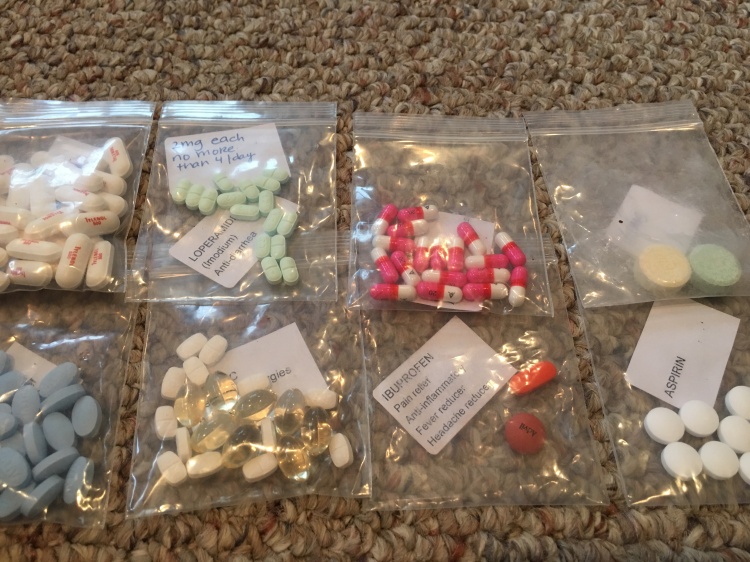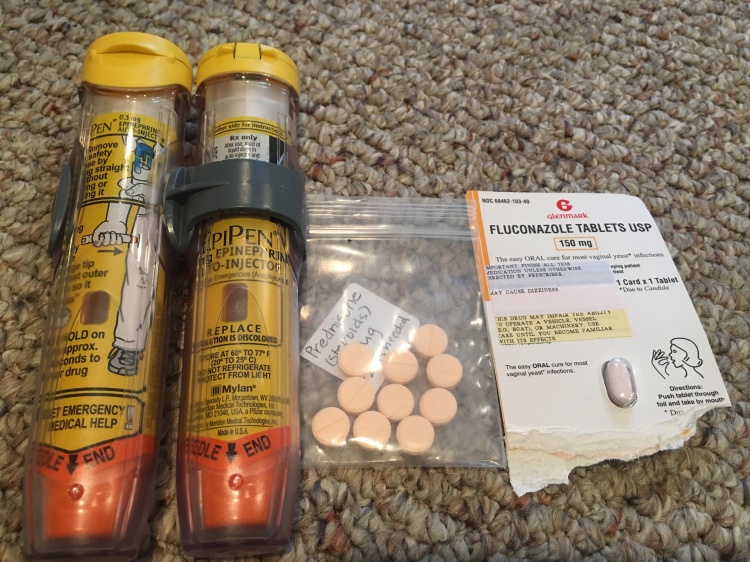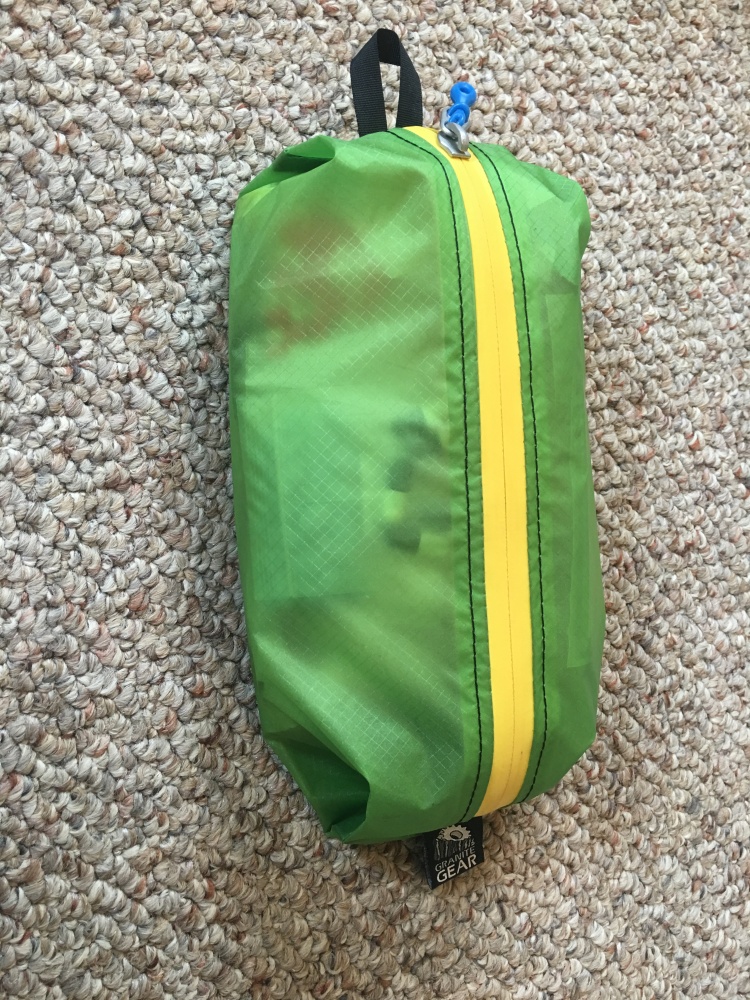My first aid kit is the one area of my backpack where I consider the weight of the items last. You will never regret carrying your first aid supplies when you need them. I tend to combine my first aid stuff and my toiletries into one water resistant sack. This green one from Granite Gear is the perfect size for everything I carry – it is 2.4L (the XL).
I also keep two Kindle books (Wilderness First Aid Responder and First Aid a Pocket Guide) about backcountry safety and basic first aid downloaded onto my phone. I do have a First Aid and CPR certification but it is nice to have a reference handy. Keeping the books downloaded means I don’t need access to the internet to use them and I can use the search feature to quickly locate information I need. I’m carrying my phone anyway so this is an easy way to have additional information at my fingertips that costs very little and weighs nothing extra. I make sure to let my hiking companions know about this information on my phone and I remove my security code so they can easily access the books if they need to. I also ask them if they have any specific medical issues I should know about. It is always better to have more information on hand.
Here is a peak into my first aid/toiletry kit from my last backpacking trip on the Northville Placid Trail.

Toiletries
- A hair brush. I know, it’s the woods – but my hair needs to be brushed otherwise it will need to be cut off. I found this out the hard way when I was backpacking around New Zealand when I was 20. I ended up shaving my head because my hair quickly got to a point where I had no other choice. (This is a true story. My parents were very confused when I came home after that trip.) I use a wet brush because it works really well on my hair in all conditions. Every morning I brush it out and braid it. Know thy hair!
- What is even worse than carrying a hair brush? Carrying deodorant. Ugh, I know. But really people, at the end of two days I can’t even stand to my own odor and people noticeably pull away from me. It’s embarrassing. So now I carry just a small travel sized natural deodorant (or completely chemically laden one if that is all I can find). It makes me feel more comfortable when I am talking to other people or have to go into town and I like the way it smells. Judge all you want!
- GUM soft picks (tooth picks). I love these little tooth picks and it never fails that when others see I have them, they want them too. They are a great addition to your dental care in the woods.
- Ear plugs. Ear plugs serve a few purposes — sometimes I can’t sleep because I hear too much. A chipmunk sounds like a bear or someone is snoring or the wind is going crazy. Some people are lulled to sleep by these noises but I am just kept awake. I always carry a few pairs of ear plugs and I can attribute many nights of sleep to having them with me.
- Travel sized toothpaste and toothbrush. For obvious purposes.
- Travel sized eye drops – these can be helpful in the morning if you have been sitting around a fire all night. Sometimes the smokiness gets to my eyes. They are also useful if a bug gets stuck in your eye. This has happened to me quite a few times.
- A few cotton swabs.
First Aid

- Quick Clot (Celox) is a product that I carry for open wounds that are bleeding a lot. Apply the gauze strip to the wound and it will help the blood to clot quickly and stop bleeding.
- Steri-Strips are a substitute for stitches.
- Moleskin is used for blisters. I also carry Leukotape wrapped around a water bottle (with some duct tape also wrapped around the same water bottle) and I frequently use the Leukotape and Moleskin together (for example: I will put the hole of the moleskin directly over the blister until the blister is in a flat plane with the rest of the foot. Then I cover the entire thing with Leukotape. If I feel a hot spot I use Leukotape to cover the entire area and generally that will prevent a blister from forming. Sometimes though you just don’t feel a blister until it is too late).
- Triple antibiotic ointment/neosporin – this goes on every cut that I have.
- A variety of bandaids.
- Afterbite – the only effective anti-itch bug bite treatment, IMO.
- Alcohol pads – for cleaning small cuts.
- Tweezers – I carry a needle-nose tweezer and regular tweezers. For removing ticks, splinters, grabbing and pull small threads or rope, etc. I am pretty picky about my tweezers and I only use Tweezerman brand. I find they are absolutely the best. We live in an area with a lot of ticks and they have proven themselves time and time again.
- Needle, thread and safety pins. Mostly useful for popping blisters. For a blister that keeps returning I simply thread a small piece of thread through the needle and leave the tread in the blister overnight. It keeps it open and allows it to drain. Make sure you sanitize the needle or pin first before poking yourself!
Medication

- I carry all of my meds in these little plastic bags that are clearly labelled. I use mailing labels that I cut and stick to the inside of the bag. I am surprised how many people don’t know the difference between tylenol or ibuprofen or aspirin or aleve and I would suggest you read up on it before heading out.
- The OTC meds I routinely carry: tylenol, ibuprofen, apsirin, Aleve, Benadryl, TUMS, Imodium and Zyrtec. The first four are for pain relief and aspirin is also a blood thinner. TUMS and Imodium are for stomach issues and Benadryl and Zyrtec are for allergic reactions. For me, personally, Zyrtec stops itching from poison ivy, food allergies, hives, etc. Benadryl is for bee stings or sometimes it can also help you sleep.
Extras

I carry three extra items in my first aid kit:
- An epipen and prescription steroids. This is because I am allergic to bee stings. If I get stung by a bee in a remote location I need to instantly inject the epipen and follow that up with steroids and benadryl.
- Fluconazole is something I recently added for a multi-day trip. This is also a prescription pill treatment for a yeast infection. I had read a few blogs that noted women can be more prone to yeast infections while hiking and then it happened to a friend of mine so my GYN called in a prescription for me to carry on the trail.

In conclusion….
All of this fits nicely in my little green sack from Granite Gear and it weighs in at a touch over one pound. It’s one pound I don’t mind carrying when I hike. (Actually I take it pretty much everywhere with me. Turns out this stuff is handy in many different scenarios.)
Please note that I am not a doctor, this is not medical advice, and you should know what you are doing independent of this post before heading out the door. I am sharing this information because when I was starting out it was really helpful for me to see what other people were carrying. Additionally, there are affiliate links embedded in this post. That means I get a small percentage of the purchase price if you use a link to buy a product. The cost does not change for you. Thanks for reading and supporting this blog!